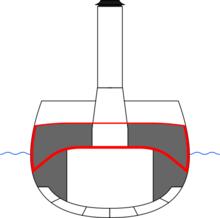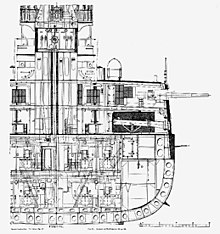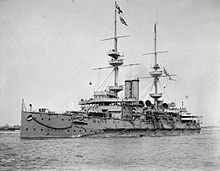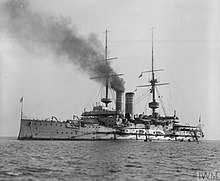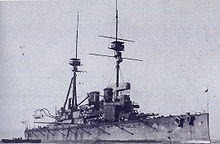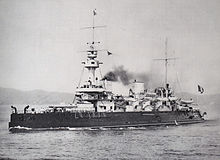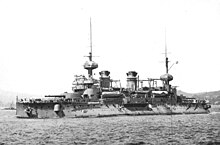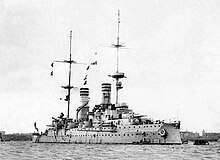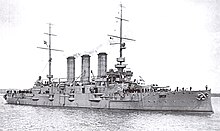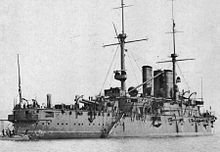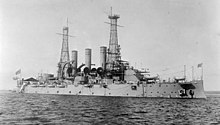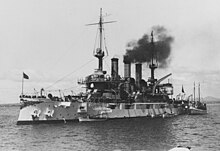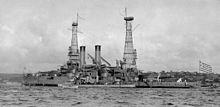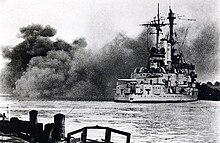Standard ship of the line
The term unit ship of the line ( English: pre-dreadnought battleship or pre-dreadnought for short , as built before a new class of warships called dreadnought ) describes a type of seagoing battleship that prevailed between the early 1890s and 1905. The term ship of the line originated from the fact that these ships drove one behind the other in a keel line in battle . Standard ships of the line replaced the armored ships of the 1870s and 1880s. The newer battleships carried a battery of heavy guns in turrets and one or more batteries of lighter guns. They were powered by coal-fired triple composite steam engines, were built of steel and protected by armor made of hardened steel.
In contrast to the chaotic development of armored ships in the preceding decades, the naval forces began building battleships worldwide in the 1890s according to a basically uniform design, which essentially followed the concept of the British Majestic class . The fundamental similarity of the designs was underlined with the increasing number of ships built. New naval powers such as Germany , Japan or the United States began building battleship fleets , while existing naval powers such as France , Russia or Great Britain expanded their fleets to meet this challenge. The most important clash between unit ships of the line took place on May 27, 1905 in the naval battle at Tsushima .
development
Standard ships of the line were developed from armored ships. The first ironclad ships, such as the French La Gloire and the British HMS Warrior , still had the appearance of sailing frigates when they were commissioned in the 1860s. They had a rigging with three slender masts, the guns were mounted in a broad-sided position. Around eight years later, in 1869, the HMVS Cerberus appeared , which was followed around four years later by the HMS Devastation (commissioned in 1873). These ships were more like the pre-dreadnoughts . Already without masts for sails, they carried their armament of four heavy cannons in two turrets on the foredeck and aft, intended for bombarding enemy coasts and docks. Due to their low freeboard , they were not fit for the ocean, and when the waves were high, the deck was flooded, which impaired the function of the guns. The navies around the world continued to build turretless ships of the line with sails that had a higher freeboard and thus sufficient seaworthiness.
The difference between battleships for use on the coast and on the high seas became blurred with the Admiral class , which was ordered in 1880. It reflected advances in armor and was protected by composite armor made of steel and wrought iron. Equipped with 12 inch (305 millimeters) or 16 inch (413 millimeters) caliber muzzle-loading cannons , these buildings continued the development of the heaviest calibers. The guns were mounted in open barbeds to save weight. Some historians see it as a decisive step in the development of a single ship of the line, others see it as an unfortunate and unsuccessful design.
The ships of the subsequent Royal Sovereign class retained the barbettes, but were uniformly equipped with 13.5-inch breech-loading guns (343 millimeters). At 14,000 tons, they had a much greater displacement, were faster than previous buildings due to the triple composite steam engines and had a higher freeboard. This enabled them to be used on the high seas without restrictions.
The pre-dreadnought concept was first fully realized with the Majestic class, the first unit of which was laid down in 1895. They became models for battleships that were to be built by the Royal Navy and other naval forces over the next few years. All were made entirely of steel, including the armor. The armament consisted of Mk VIII 12-inch rear-loading cannons. Due to the advancement of weapon technology, these were lighter and more powerful than previously used larger caliber guns. In addition, they were mounted in towers that were closed on all sides, which replaced the previously used barbeds.
The semi-dreadnoughts that appeared towards the end of this warship era took on a certain special position . For the most part, they were deliberately built, such as B. the French Danton class ; the Satsuma class, on the other hand, can be seen as a makeshift, for lack of large-caliber guns. -Enhanced firepower by intermediate caliber of 7.5 to 10 inches (190-254 millimeters;. I. D R. instead of the means artillery) and (up to 20,000 tons 18,000) they set larger displacement than conventional unit liners an intermediate step to the All-Big Gun Battleship represents The difficult fire control of two large calibers, the impacts of which could not be clearly distinguished, but above all the dreadnought revolution, quickly ended this chapter of warship building.
With the appearance of the HMS Dreadnought in 1906 and similar constructions, unit ships of the line were soon outclassed. This ship followed the trend towards heavier and more extensive armament through the implementation of the standard caliber concept ("All-Big-Gun") in the form of equipment with a total of ten guns of 12 inches (305 millimeters). Using the steam turbine as a drive made it faster than existing units. New battleships built on the concept of the HMS Dreadnought were from now on referred to as dreadnoughts , while older ones received the designation pre-dreadnoughts . However, these were only more or less slang terms, the military classification as a battleship, etc. remained unaffected. Regardless of the fact that they were conceptually out of date, unit ships of the line played an important role during the First World War and were in part still used in the Second World War.
The HMS Warrior (1860), the first ocean-going armored ship with an iron hull
HMVS Cerberus (1868), coastal defense ship for the defense of the port of Melbourne
HMS Thunderer (1871), Devastation- class with the low freeboard of earlier ironclad ships
HMS Anson (1886), Admiral-class unit with main armament in open barbeds
HMS Ramillies (1893), ocean-going battleship from the Royal Sovereign class
HMS Majestic (1895), lead ship of the Majestic class and typical unit ship of the line
HMS Agamemnon (1906), Lord Nelson class , semi-dreadnought with heavy medium artillery
Armament
Main caliber

Standard ships of the line carried different calibers for different tasks in the fight against enemy ships. The main armament consisted of four heavy cannons, which were mounted in two turrets on the center line fore and aft. Very few ships had a different main armament arrangement. These cannons had low cadence and, at least initially, limited accuracy, but they were the only cannons with sufficient penetration power to penetrate the heavy armor of the engine rooms, ammunition loads and main armament of enemy battleships.
The most common caliber of the main armament was 12 inches (305 millimeters). All British battleships from the Majestic class carried this caliber, as did all French battleships from the Charlemagne class, which were laid down from 1894 onwards. Japan, which imported most of the guns used from Great Britain, also used this caliber. In the USA both 12 and 13 inches were common up to the Maine class (keel laid in 1899), after which only 12 inch cannons were used. The 10 and 12 inch calibers were common in Russia. The Borodino- class had guns of 12 "caliber, while older ships were equipped with 10" caliber guns. The first German standard ship of the line, the SMS Kurfürst Friedrich Wilhelm , used the 28 centimeter caliber. The following classes went back to the 24 centimeter caliber, and from the Braunschweig class onwards the 28 centimeter caliber was used again.
While the caliber of the main armament remained largely the same, the performance of the guns was improved by increasing the barrel length. The introduction of slow-burning propellants made of cellulose nitrate and cordite led to a higher muzzle velocity with the longer tubes. This in turn led to a greater range and higher penetration rates with the same caliber. From the Majestic class to the Dreadnought class, the barrel length of the British 12-inch cannon grew from 35 to 45 caliber and the muzzle velocity from 737 m / s to 830 m / s.
Secondary armament
Middle artillery
The unit ships of the line also carried secondary armament. This consisted of smaller cannons, typically 6 inches in caliber. Variations from 4 to 7 inches (100 to 180 millimeters) were possible. In practice, these were rapid-fire cannons. A number of improvements helped increase the cadence. These guns used cartridge ammunition with a brass cartridge. Both the mount and the breech block were designed for quick alignment and reloading.
The task of secondary armament was to destroy the less heavily armored parts of enemy battleships. Since it was unable to penetrate the main armor, it was supposed to destroy areas such as the navigating bridge or open the firefight. They were equally important for fighting opposing cruisers and torpedo boats. The power was enough to penetrate the thinner armor of these ships, while the higher rate of fire was important for fighting smaller and more agile targets. The secondary armament was installed in various ways. Partly it was led in towers, partly in armored casemates in the sides of the hull or placed on the upper deck without armor.
Intermediate caliber of the semi-dreadnoughts
Some unit ships of the line carried an intermediate caliber, typically between 8 and 10 inches (203 to 254 millimeters) (the usual main calibers of armored cruisers). Ships with a heavy main caliber and a heavy secondary caliber are also known as semi-dreadnoughts . This intermediate caliber was an attempt to increase the fighting power of the ships for fighting battleships or at greater distances by reinforcing the heavy artillery. Most of the time, these ships did not carry conventional middle artillery. The United States Navy pioneered intermediate calibers on Indiana- class and Kearsarge- class ships , but abandoned this approach between 1897 and 1901. The US Navy not only took up the approach of the "semi-heavy" artillery again, they drove it to extremes with the Connecticut class of 1908; In addition to the 4 × 12-inch main and 8 × 8-inch secondary artillery (both in twin turrets), the six ships of this class had 10 7-inch middle artillery in single casemated mounts and 20 3-inch anti-torpedo guns.
After a short time, this approach was taken up by the Royal Navy and the navies of Russia ( Andrej-Pervozvannyj-class ), Italy ( Vittorio-Emanuele-class ), France ( Danton-class ) and Japan ( Satsuma-class ). This later generation of the standard ships of the line, however, was completed almost simultaneously with the HMS Dreadnought and was therefore already obsolete when it was commissioned. Only the German Navy renounced this step and instead increased the caliber of their funds artillery to 17 centimeters in Braunschweig - and Germany class . However, in the first drafts for the large ships of the line of the Nassau class , she had at least considered the use of 24-centimeter guns in four side twin turrets.
During the era of the ironclad, the distance at which naval battles were fought increased. During the First Sino-Japanese War in 1894, five naval battles were fought at a distance of 2,000 meters, but in the 1904 Sea Battle in the Yellow Sea the battle began at 6,500 meters. This increase is due on the one hand to the improvement of weapons and fire control procedures, and on the other hand to the greater combat distances of the torpedoes . As a result, the caliber of the secondary armament was increased until it finally reached the size used for the intermediate calibers . The last two unit ships of the Royal Navy, the HMS Lord Nelson and the HMS Agamemnon of the Lord Nelson class , carried ten 9.2-inch cannons as secondary armament.
Tertiary armament
The armament of the unit ships of the line was completed by the tertiary armament. The calibers ranged from 8.8-centimeter quick-loading cannons down to machine guns. Their task was to fight torpedo boats at short range and to paint the decks and superstructures of enemy battleships. With the increasing importance of aviation, anti-aircraft guns found their way into the armament, especially in the ships that were still in use during World War II.
Torpedo armament
In addition, many pre-dreadnoughts were equipped with torpedo tubes. These were permanently installed and lay above or below the waterline. At that time, the common caliber for torpedoes was 16 inches (406 millimeters). The combat range was several hundred meters up to 3 kilometers. Still, it was virtually impossible for a battleship to hit with a torpedo.
protection
Standard ships of the line carried a considerable amount of armor. Experience showed that instead of uniform armoring of the ship, concentrating the armor on the critical areas was the better solution. The central part of the hull, in which the boilers and steam engines were arranged, was protected by belt armor . This started below the waterline and extended upwards. It was closed to the front and rear by armored transverse bulkheads. This central citadel was introduced to protect the machinery from the most powerful projectiles. The main armament and ammunition loads were also protected by the armor. The beginning of the standard ships of the line was marked by the transition from open barbeds to armored towers closed on all sides.
Belt armor usually decreased in thickness towards the ends of the ship. Sometimes the thickness also decreased from the citadel to the superstructures. The deck was usually lighter armored. Its armor was between four and six inches thick. This armor was used to prevent the superstructure from being destroyed by explosive projectiles, it did not protect against armor-piercing shells.
The battleships of the later 1880s, for example the Royal Sovereign class, had composite armor made of wrought iron and steel. This armor was later replaced by one made of hardened steel. The manufacturing process was developed by Harvey in the USA. First tested in 1891, such armor became common on ships built in 1893/95. However, they were only used for a short time. In 1895 the Kaiser Friedrich III. equipped with even better armor from Krupp . In Europe, the use of Krupp armor became common within five years, only the USA stuck to the Harvey tank into the 20th century. The improved armor meant that the ships were better protected by a thinner and lighter armor. A composite armor with a thickness of 30 centimeters corresponded to a Harvey armor of 19 centimeters or a Krupp armor of 14.5 centimeters in terms of protection.
drive

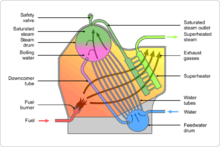
All standard ships of the line were propelled by steam engines. Most ships reached speeds between 16 and 18 knots . Composite steam engines were already installed in the armored ships , but by the end of the 1880s, three-stage composite steam engines became operational. Initially these machines were designed with three cylinders, i. H. for each steam expansion stage there was a size-adapted cylinder. The crank offset was 120 degrees. Later the low pressure stage was designed with two cylinders; the machines then had four cylinders with a 90 degree crank offset. This resulted in a smoother run. Some fleets, but not the Royal Navy, also used composite quadruple steam engines.
The greatest progress in mechanical engineering of this era was achieved through the use of higher operating pressures in the boiler. The early cylindrical flame tube boilers were replaced by more efficient water tube boilers , which generated steam at higher pressure while consuming less fuel. Water tube boilers were also safer to operate. The risk of an explosion was lower and they were more flexible than fire tube boilers. Belleville-type water-tube boilers were introduced into the French Navy in 1879, but it took the Royal Navy until 1894 to adopt this type of boiler for protected cruisers and battleships.
Coal was used as fuel to generate steam, although first experiments with oil firing were made in some fleets. The speed of the ships could be increased by one or two knots by blowing air into the furnace, but the risk of the boiler being destroyed was high.
The steam engines drove two or three propellers . In Germany and France, three-screw ships were preferred. This drive enabled a shorter and more compact design of the machine system and made armor protection easier. Maneuverability and insensitivity to damage were also better, but these ships were larger and heavier than two-screw ships that were preferred in most other fleets.
Fleet use
The standard ships of the line were the core element of the fleet, which was composed of different types of ships. Many of the older ironclad ships were still in service. The unit ships of the line were in service with various cruisers: modern battleships , the reduced in principle unit battleships were, with lighter protected cruisers and older unarmoured cruisers , sloops and frigates , which were partially built still made of iron or wood. Standard ships of the line were threatened by torpedo boats in battle . In the era of the standard ships of the line, in view of this threat, the first destroyers were built whose purpose is derived from their original designation "torpedo boat destroyer". At the same time, the first practical submarines were created .
In the era of the unit ships of the line, the beginning of the end of the balance between the naval forces of France and Russia on the one hand and the Royal Navy on the other. During this time the rise of the new sea powers Germany, Japan and the USA also began. The new ships of the Imperial Japanese Navy , and to a lesser extent those of the United States Navy , aided the colonial expansion of these countries.
Almost in the entire epoch of the unit ships of the line there were no conflicts between ships of this type. The wars at the end of this epoch are an exception. The First Sino-Japanese War had an impact on the further development of pre-dreadnoughts , but the largest ships used were cruisers. During the Spanish-American War , the US Navy battle fleet fought against the Spanish fleet, which had no unit ships of the line. Only during the Russo-Japanese War did battles between unit ships of the line take place in two cases: the naval battle in the Yellow Sea on August 10, 1904 and the naval battle near Tsushima on May 27, 1905.
The gunboat policy of the great powers was implemented exclusively by cruisers or smaller types of ships. On British Zanzibari war involved three British protected cruiser. During the Boxer Rebellion, there were unit ships of the line in the fleets of Western countries, but destroyers , gunboats , cruisers and sloops were used against Chinese forces .
Europe
The European fleets dominated the seas during the pre-dreadought era. The British Royal Navy was the world's largest fleet, although Britain's traditional rivals France and Russia and new naval powers like Germany went to great lengths to break British supremacy.
United Kingdom
In 1889 the two-power standard was formally established with the Naval Defense Act . This standard stated that the number of battleships in the Royal Navy should be at least as large as the sum of the number of battleships in the next two largest naval forces. At the time, it was France and Russia, who became British allies in the early 1890s. After the Royal Sovereign and Majestic classes went into service, a shipbuilding program followed, which provided for much faster growth than in previous years. The Canopus , Formidable , Duncan, and King Edward VII classes quickly followed one another between 1897 and 1905. If you include two ships originally commissioned for Chile but then taken over by the Royal Navy , a total of 39 battleships had been in service or under construction since the Majestic class by 1904 . Over two dozen older battleships remained in service.
Standard ships of the line:
-
Majestic class
- HMS Magnificent (1894)
- HMS Majestic (1895)
- HMS Prince George (1895) - briefly renamed HMS Victorious II in 1918/19
- HMS Victorious (1895) - renamed HMS Indus II in 1920
- HMS Jupiter (1895)
- HMS Mars (1896)
- HMS Hannibal (1896)
- HMS Caesar (1896)
- HMS Illustrious (1896)
-
Canopus class
- HMS Canopus (1897)
- HMS Goliath (1898)
- HMS Albion (1898)
- HMS Ocean (1898)
- HMS Glory (1899) - renamed HMS Crescent in 1920
- HMS Vengeance (1899)
-
Formidable class
- HMS Formidable (1898)
- HMS Irresistible (1898)
- HMS Implacable (1899)
- HMS London (1899)
- HMS Bulwark (1899)
- HMS Venerable (1899)
- HMS Queen (1902)
- HMS Prince of Wales (1902)
-
Duncan class
- HMS Russell (1901)
- HMS Duncan (1901)
- HMS Cornwallis (1901)
- HMS Exmouth (1901)
- HMS Montagu (1901)
- HMS Albemarle (1901)
-
Swiftsure class
- HMS Swiftsure (1903) - ex Chilean Constitución , purchased in 1903
- HMS Triumph (1903) - ex Chilean Libertad , bought in 1903
-
King Edward VII class
- HMS Britannia (1904)
- HMS King Edward VII (1903)
- HMS Dominion (1903)
- HMS Commonwealth (1903)
- HMS Hindustan (1903)
- HMS New Zealand (1904) - renamed HMS Zealandia in 1911
- HMS Hibernia (1905)
- HMS Africa (1905)
Semi-Dreadnoughts:
-
Lord Nelson class
- HMS Agamemnon (1906)
- HMS Lord Nelson (1906)
The last British liner ships of the Lord Nelson class were only put into service after the HMS Dreadnought .
France
France , the traditional maritime power rivaling Great Britain, had suspended the construction of battleships during the 1880s. The dominant doctrine of the Jeune École favored cruisers and torpedo boats over battleships. After this influence subsided, the battleship Brennus was laid down in 1891 . In contrast to the Royal Navy, which had larger series of the respective battleship classes built, the French ships were one-offs. The armament was strange too. The Brennus carried three cannons of the caliber 34 centimeters, their successors each two 30.5-centimeter and two 27.4-centimeter cannons in individual turrets. It was not until the Charlemagne class that the French navy switched to the standard installation of four 30.5-centimeter cannons in twin towers. The Jeune École retained a great influence on the French naval war strategy. By the end of the 19th century, France had given up the race with Britain for the number of battleships. France suffered most from the revolution caused by the dreadnought , because when it appeared there were four Liberté- class battleships under construction, and construction of another six Danton- class began after that.
Transition types to the standard ship of the line:
- Brennus (1891)
- Charles Martel (1893)
- Jauréguiberry (1893)
- Carnot (1894)
- Massena (1895)
- Bouvet (1896)
Standard ships of the line:
-
Charlemagne class
- Charlemagne (1895)
- Saint-Louis (1896)
- Gaulois (1896)
- Iéna (1898)
- Henri IV (1899)
- Suffren (1899)
-
Republique class
- République (1902)
- Patrie (1903)
-
Liberté class
- Liberté (1905)
- Justice (1904)
- Democratie (1904)
- Vérité (1907)
Semi-Dreadnoughts:
Germany
Germany did not begin to build its own battle fleet until the 1890s, but as early as 1905 there was a maritime arms race with the Royal Navy . That year, 23 battleships were in service or under construction. This rapid increase was due to Alfred von Tirpitz 's single-minded approach and the growing sense of national rivalry with Great Britain, and was made possible by the Naval Acts of 1898 and 1900. German battleships in the years from 1895 were the Emperor Frederick III - , Wittelsbach - and Braunschweig class . The development reached its climax with the Deutschland class , which was still in service during the First World War. Overall, the German ships were less powerful than their British equivalents, but just as robust.
Transitional design to the standard ship of the line:
-
Brandenburg class
- SMS Elector Friedrich Wilhelm (1891) - sold to Turkey in 1910, as Barbaros Hayreddin in Turkish service
- SMS Brandenburg (1891)
- SMS Weißenburg (1891) - sold to Turkey in 1910, as Torgud Reis in Turkish service
- SMS Wörth (1892)
Standard ships of the line:
-
Kaiser Friedrich III class
- SMS Kaiser Friedrich III. (1896)
- SMS Kaiser Wilhelm II. (1897)
- SMS Kaiser Wilhelm the Great (1899)
- SMS Emperor Charlemagne (1899)
- SMS Emperor Barbarossa (1900)
-
Wittelsbach class
- SMS Wittelsbach (1900)
- SMS Wettin (1901)
- SMS Zähringen (1901)
- SMS Swabia (1901)
- SMS Mecklenburg (1901)
-
Braunschweig class
- SMS Braunschweig (1902)
- SMS Alsace (1903)
- SMS Hessen (1903)
- SMS Prussia (1903)
- SMS Lorraine (1904)
-
Germany class
- SMS Germany (1904)
- SMS Hanover (1905)
- SMS Pomerania (1905)
- SMS Silesia (1906)
- SMS Schleswig-Holstein (1906)
Austria-Hungary
The k. u. k. The Kriegsmarine experienced an upswing during the 1890s. A total of twelve battleships were commissioned, but only the six ships of the Monarch and Habsburg classes were completed before the Dreadnought .
Standard ships of the line:
-
Monarch class
- SMS Budapest (1895)
- SMS Monarch (1895)
- SMS Vienna (1895)
-
Habsburg class
- SMS Habsburg (1900)
- SMS Árpád (1901)
- SMS Babenberg (1902)
-
Archduke Karl class
- SMS Archduke Karl (1903)
- SMS Archduke Friedrich (1904)
- SMS Archduke Ferdinand Max (1905)
Semi-Dreadnoughts:
-
Radetzky class
- SMS Archduke Franz Ferdinand (1908)
- SMS Radetzky (1909)
- SMS Zrinyi (1910)
Italy
Italy laid down eight battleships between 1893 and 1904 . The last two classes were remarkably fast ships, but the Regina Margherita class was too weakly armored and the Regina Elena class too lightly armed. These ships were more in keeping with the concept of the battle cruiser .
Standard ships of the line:
-
Emanuele Filiberto class
- RN Emanuele Filiberto (1897)
- RN Ammiraglio di Saint Bon (1897)
-
Regina Margherita class
- RN Regina Margherita (1901)
- RN Benedetto Brin (1901)
-
Regina Elena class (also Vittorio Emanuele class)
- RN Regina Elena (1904)
- RN Vittorio Emanuele (1904)
- RN Napoli (1905)
- RN Roma (1907)
Russia
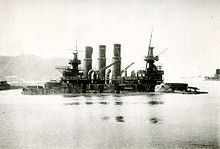
Russia also began expanding its fleet in the 1890s. The main reason was to try to contain Japanese expansion in the Far East. The Petropavlovsk- class battleships, commissioned in 1892, corresponded to the British Royal Sovereign- class. The backwardness of the Russian shipbuilding industry resulted in some ships being built abroad. The most powerful design, the Retwisan , was built in the United States. The Borodino class was essentially a Russian replica of the Zessarevich made in France . The Russo-Japanese War ended disastrously for the Russian battleships. Of the fifteen battleships built since Petropavlovsk , eleven were sunk or interned during the war. The most famous of all Russian battleships, the Knjas Potjomkin Tawritscheski , was interned in Constanța in 1905 after the occupation rebelled and the flight to Romania followed , but was later returned and put back into service.
Transition types to the standard ship of the line:
- Dwenadzat Apostolow (1890) - Black Sea Fleet
- Navarin (1891)
- Tri Svjatitelja (1893) - Black Sea Fleet
- Sissoi Veliki (1894)
Standard ships of the line:
-
Petropavlovsk class (also Poltava class)
- Poltava (1894) - lost to Japan in 1905, as Tango in Japanese service; 1916returned to Russiaas Tschesma
- Petropavlovsk (1894)
- Sevastopol (1895)
- Rostislaw (1896) - Black Sea Fleet
- Pereswet class
- Knjas Potjomkin Tavrichesky (1900) - Black Sea Fleet
- Retwisan (1900) - lost to Japan in 1905 as a Hizen in Japanese service
- Zessarevich (1901)
-
Borodino class
- Borodino (1901)
- Emperor Alexander III (1901)
- Oryol (1902) - lost to Japan in 1905 when Iwami in Japanese service
- Knyaz Suvorov (1902)
- Slava (1903)
-
Yevstafi class - Black Sea Fleet
- Ioann Slatoust (1906)
- Yevstafi (1906)
Semi-Dreadnoughts:
-
Andrei Pervosvanny class
- Andrei Pervoswanny (1906)
- Emperor Pavel I (1907)
America and the Pacific
United States
The construction of the first standard ships of the line for the US Navy began in 1891. These ships were short range coastal defense ships similar to the HMS Hood . The main difference, however, was the introduction of an intermediate caliber battery of 8-inch guns. Until the appearance of the Virginia class, the US Navy preferred battleships for near-shore use. Nevertheless, during the Spanish-American War of 1898 , these ships ensured the superiority of the US Navy over the outdated Spanish fleet, which had no unitary ships of the line. The Virginia class and the two subsequent classes were only completed after the commissioning of the HMS Dreadnought and were already obsolete at that time. The US Navy had started to build its own dreadnoughts at this point . The American Great White Fleet , consisting of 16 standard liners, circled the world from December 16, 1907 to February 22, 1909.
Transition types to the standard ship of the line:
Standard ships of the line:
-
Indiana class
- USS Indiana (1893)
- USS Massachusetts (1893)
- USS Oregon (1893)
- USS Iowa (1896)
-
Kearsarge class
- USS Kearsarge (1898)
- USS Kentucky (1898)
-
Illinois class
- USS Illinois (1898)
- USS Alabama (1898)
- USS Wisconsin (1898)
-
Maine class
- USS Maine (1901)
- USS Missouri (1901)
- USS Ohio (1901)
-
Virginia class
- USS Virginia (1904)
- USS Nebraska (1904)
- USS Georgia (1904)
- USS New Jersey (1904)
- USS Rhode Island (1904)
-
Connecticut class
- USS Connecticut (1904)
- USS Louisiana (1904)
- USS Vermont (1905)
- USS Kansas (1905)
- USS Minnesota (1905)
- USS New Hampshire (1906)
-
Mississippi class
- USS Mississippi (1905) - Sold to Greece in 1914, in Greek service as VP Kilkis
- USS Idaho (1905) - Sold to Greece in 1914, in Greek service as VP Limnos
Japan
Japan was involved in both naval wars of the unit line ship era. The first Japanese standard ships of the line, the Fuji class, were still under construction when the Sino-Japanese War broke out in 1894–1895. During this war, the Chinese fleet, consisting of a mixture of outdated ironclads and cruisers, was defeated by the Japanese armored cruisers and armored cruisers in the battle of the Yalu River. After their victory and under the impression of the growing Russian threat in the region, the Japanese Navy ordered four unit ships of the line. Together with the two ships of the Fuji class, it formed the core of the Japanese battle fleet during the naval battle in the Yellow Sea and the naval battle of Tsushima. After the Russo-Japanese War, Japan built two more classes of pre-dreadnoughts .
Standard ships of the line:
- Fuji class
-
Shikishima class
- Shikishima (1898)
- Hatsuse (1899)
- Asahi (1899)
- Mikasa (1900)
- Tango - ex Russian Poltava , captured in 1905
- Sagami - ex Russian Peresvet , captured in 1905
- Suō - ex Russian Pobeda , captured in 1905
- Hizen - ex Russian Retwisan , captured in 1905
- Iwami - ex Russian Oryol , captured in 1905
- Katori class
Semi-Dreadnoughts:
overaging
In 1906 the commissioning of the HMS Dreadnought led to the obsolescence of all existing battleships. The Dreadnought carried ten 12-inch cannons instead of the previously usual four, omitting the secondary armament. She could use eight heavy artillery pieces, twice as many as a standard ship of the line, in one broadside. Six cannons could fire ahead, compared to two for the unit ships of the line. The transition to the standard caliber was a logical consequence of the growth in the caliber and range of the secondary artillery of the last standard ships of the line. In Japan and the United States ships with similar armament were already under construction, but they could not be completed before the HMS Dreadnought . It was believed that only the larger calibers could be used effectively in battle. Due to the larger number of 12-inch guns, the combat power of the HMS Dreadnought was two to three times higher than that of the existing battleships.
Armament wasn't the only key advantage of the dreadoughts . They were powered by steam turbines that allowed a speed of 20 knots. With the speed a good two knots higher, they were able to outmaneuver their opponents. The dreadnoughts literally outclassed the earlier battleship designs.
Nevertheless, the unit ships of the line remained in active service. Precisely because they were out of date, they played an important role in conceptual considerations of naval warfare. Dreadnoughts and battle cruisers were seen as essential in the anticipated sea battles. But they were threatened by mines and submarine attacks. That is why they were carefully guarded and kept in their bases as far as possible. The obsolescence and dispensability of the standard ships of the line made them appear suitable for more dangerous missions and distant theaters of war.
The only remaining standard ship of the line is the flagship of the Japanese fleet during the Battle of Tsushima. The Mikasa has been a museum ship in Yokosuka since 1925 .
First World War

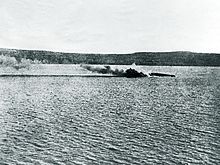

During the First World War a large number of unit ships of the line were in service. Advances in mechanical engineering and weapons technology meant that they were already inferior to newer armored cruisers. Compared to modern battleships or battle cruisers, they were completely out of date. Regardless, they played an important role during the war.
This first became apparent during the skirmishes between British and German warships in the South Atlantic in the fall of 1914. When two German cruisers threatened British shipping there, the Admiralty was initially unable to withdraw modern battle cruisers from Europe. Instead, a standard ship of the line, the HMS Canopus , was moved to the South Atlantic. But instead of reinforcing the British cruisers, they stayed behind them due to their low speed during the sea battle at Coronel and could not intervene in the battle. In this naval battle, the Royal Navy suffered its first defeat in more than a hundred years. During the sea battle in the Falkland Islands , she was set aground to defend the port of Port Stanley . She recorded the battle with the SMS Gneisenau at a very great distance and was able to get a hit in the chimney of the Gneisenau . This hit was obtained with a training grenade without an explosive charge, which had accidentally stayed in the tube overnight. The live ammunition volleys were too short. From the British point of view, this hit caused the German ships to break off the attack on the British ships, which were bunkering coal in the port, unprotected and immobile. The battle was ultimately decided by the two modern Invincible- class battlecruisers . This event was the only case in which a British unit line ship had any effect on an opposing ship in a battle during World War I.
In the Black Sea , during the sea battle at Cape Sarych, there were a few brief actions by Russian unit ships of the line against the Turkish battle cruiser Yavuz .
By the British, French and German fleets, unit ships of the line were used on secondary theaters of war when the use of modern ships was considered too risky. The German fleet used its standard ships at times in the Baltic Sea . However, the greatest number of ships of this type were used on the British and French sides during the Battle of Gallipoli . Twelve British and French unit ships of the line formed the core of the naval forces in the battle for the Dardanelles . Her task was to support Queen Elizabeth in the fight against the Turkish positions on land. The Irresistible , the Ocean and the French Bouvet sank after being hit by mines. The battle cruiser Inflexible and the French ships of the line Suffren and Gaulois were badly damaged. Losing the Queen Elizabeth in the minefield should not be risked. The remaining unit ships of the line were, however, inferior to the Turkish ships that had taken position on the other side of the strait. The operation had failed. Standard ships of the line were used again when landing on Gallipoli. Three more were lost: Goliath , Triumph and Majestic , the latter two due to the German submarine U 21 .
A squadron of German standard ships of the line took part in the Battle of the Skagerrak in 1916. The German sailors called them the "five-minute ships" after the lifespan they were allowed in a battle with modern warships. Despite their limitations, these ships played an important role in the battle. When the German fleet withdrew, they shielded the breakthrough by the British cruisers. Only Pomerania was lost to torpedo hits during the chaotic night battle.
After the armistice of November 1918 , the US Navy converted 15 older battleships, eight armored cruisers, and two larger armored cruisers into troop carriers. These ships made one to six Atlantic crossings each, bringing a total of more than 145,000 people back to the United States.
Second World War
After the First World War, most of the existing ships of the line - including the older dreadnoughts - were disarmed according to the specifications of the Washington Naval Agreement . The fleet agreement limited the number and tonnage of different types of ships for the fleets of individual countries. The existing leeway was, if possible, exploited by more modern types. Most ships of the line were scrapped, some were converted into training or target ships or used for other purposes. The Japanese Mikasa fell under an exemption from the fleet agreement and was retained as a museum ship.
Germany had not participated in the negotiations on the Washington Naval Agreement and was not subject to its restrictions. However, the size of the German fleet was limited by the provisions of the Treaty of Versailles. Germany was able to keep eight outdated liners, but a maximum of six could be in service at the same time. These ships were used as armored coastal defense ships. Two of these ships, the Silesia and the Schleswig-Holstein , were still used as training ships during World War II . The Schleswig-Holstein opened fire with the Polish positions on the Danziger Westerplatte on 1 September 1939, the hostilities of World War II. In December 1944 it sank after a bombing raid. The Silesia was set ashore in March 1945 after being hit by mines and bombs.
Three disarmed ships of the line were sunk during the fighting of World War II. The Greek ships Kilkis and Limnos , bought by the US Navy in 1914, were sunk by dive bombers after the German invasion of Greece in 1941, although they were already decommissioned. In the Pacific, the Japanese Asahi , which was used as a workshop ship, was torpedoed by an American submarine in May 1942. She had already participated in the 1905 naval battle of Tsushima.
Individual evidence
- ↑ Roberts, p. 112.
- ↑ Beeler, pp. 93-95; see also p. 169 for a graphical illustration of the problem.
- ↑ Beeler, pp. 167–168: Beeler contradicts the view of Oscar Parkes, who sees similarities between the Admiral class and the Royal Sovereign .
- ↑ Beeler, p. 168.
- ↑ Gardiner, p. 116.
- ^ Roberts, p. 117: "Many regard them as the first true pre-dreadnoughts ..."
- ^ Gardiner, p. 117.
- ↑ a b Massie, Dreadnought , pp. 474-475.
- ↑ Chesneau, p. 200.
- ↑ a b c Sumrall, p. 14.
- ↑ Roberts, pp. 117-125.
- ↑ Roberts, p. 113.
- ^ Campbell, p. 169.
- ^ Campbell, p. 163.
- ↑ a b Roberts, p. 122.
- ↑ Roberts, pp. 125-126.
- ↑ Sondhaus, pp 170, 171, 189th
- ↑ Roberts, pp. 125-6.
- ^ Hill, p. 155.
- ↑ a b Roberts, p. 117.
- ↑ Roberts, pp. 132-133.
- ^ The Eclipse of the Big Gun , p. 8.
- ↑ Sondhaus, S. 166th
- ^ Roberts, p. 132.
- ↑ a b Roberts, p. 114.
- ↑ Griffiths, pp. 176-177.
- ^ Griffiths, p. 177.
- ↑ Sondhaus, pp. 155–156, 182–183.
- ↑ Sondhaus, pp. 170–171.
- ↑ Sondhaus, S. 186th
- ↑ Sondhaus, S. 161st
- ↑ Sondhaus, p 168., 182
- ↑ The Formidable class is divided into the Formidable , London , and Queen subclasses in some sources .
- ↑ Sondhaus, S. 167th
- ↑ Sondhaus, pp. 180-181.
- ↑ Roberts, p. 125.
- ^ Roberts, p. 126.
- ↑ Roberts, pp. 120-121.
- ↑ navy.mil: The Great White Fleet ( Memento of the original from October 6, 2009 in the Internet Archive ) Info: The archive link was inserted automatically and has not yet been checked. Please check the original and archive link according to the instructions and then remove this notice.
- ^ Roberts, p. 123.
- ^ Massie, Dreadnought , p. 473.
- ↑ Sumrall, p. 15; Jentschura, Jung, Mickel p. 23.
- ^ Massie, Dreadnought , pp. 471-473.
- ^ Massie, Castles of Steel , p. 433.
- ^ G. Bennett: Naval Battles of the First World War , p. 114.
- ^ Massie, Castles of Steel , pp. 466-467.
- ^ Massie, Castles of Steel , pp. 483, 492-493.
- ^ Massie, Castles of Steel , p. 564.
- ^ Massie, Castles of Steel , p. 634.
- ^ Massie, Castles of Steel , p. 648.
- ↑ USN Ship Types - World War I Transports - Combat Warships employed as Transports . history.navy.mil. Retrieved March 6, 2008.
- ↑ Kennedy, p. 275.
- ↑ Lonton 1975, p. 13.
- ↑ Chesneau, p. 404.
- ↑ Jentschura, Jung, Mickel p. 18.
literature
- John Beeler: Birth of the Battleship: British Capital Ship Design 1870–1881 . Caxton, London 2003. ISBN 1-84067-534-9
- RA Burt: British Battleships 1889-1904 Annapolis, MD: Naval Institute Press, 1988. ISBN 0-87021-061-0 .
- Roger Chesneau (Ed.): Conway's All the World's Fighting Ships 1922-1946 . Conway, London 1980, ISBN 0-85177-146-7 .
- Robert Gardiner, Andrew Lambert : Steam, Steel and Shellfire: The Steam Warship, 1815-1905 . Conways, London 2001, ISBN 0-7858-1413-2 .
- J. Roberts: The Pre-Dreadnought Age in Gardiner Steam, Steel and Shellfire .
- J. Campbell: Naval Armaments and Armor in Gardiner Steam, Steel and Shellfire .
- D. Griffiths: Warship Machinery in Gardiner Steam, Steel and Shellfire .
- Robert Gardiner: The Eclipse of the Big Gun: The Warship 1906-45 . Conways, London 1992, ISBN 0-85177-607-8 .
- R. Sumrall: The Battleship and Battlecruiser in Gardiner Eclipse of the Big Gun .
- Robert Hill: War at Sea in the Ironclad Age . Cassell, London 2000, ISBN 0-304-35273-X .
- Jentschura Jung & Mickel: Warships of the Imperial Japanese Navy 1869-1946 , ISBN 0-85368-151-1 .
- John Keegan: The First World War . Pimlico, London 1999, ISBN 0-7126-6645-1 .
- Paul M. Kennedy: The Rise and Fall of British Naval Mastery . Macmillan, London 1983, ISBN 0-333-35094-4 .
- HT Lenton: German Warships of the Second World War . Macdonald and Jane's, London 1975, ISBN 0-356-04661-3 .
- Robert K. Massie : Dreadnought: Britain, Germany and the Coming of the Great War . Pimlico, London 2004, ISBN 978-1-84413-528-8 .
- Robert K. Massie: Castles of Steel: Britain, Germany and the Winning of the Great War at Sea . Pimlico, London 2005, ISBN 1-84413-411-3 .
- Lawrence Sondhaus: Naval Warfare 1815-1914 . Routledge, London 2001, ISBN 0-415-21478-5
- Siegfried Breyer: Battleships and battle cruisers 1905-1970 . Lehmanns Verlag, Munich 1970, ISBN 3-88199-474-2











